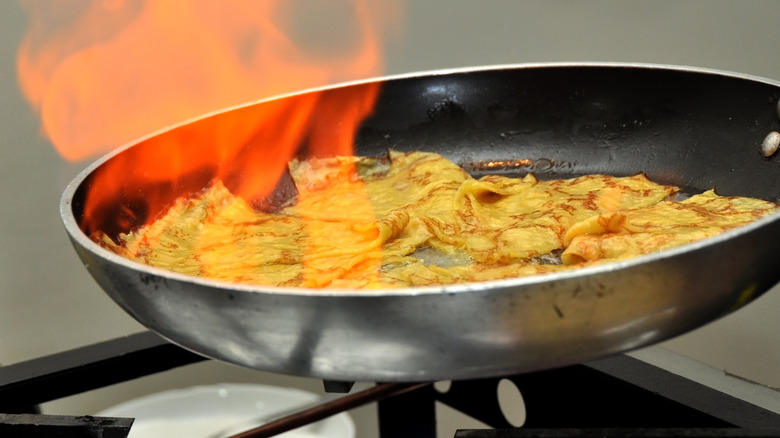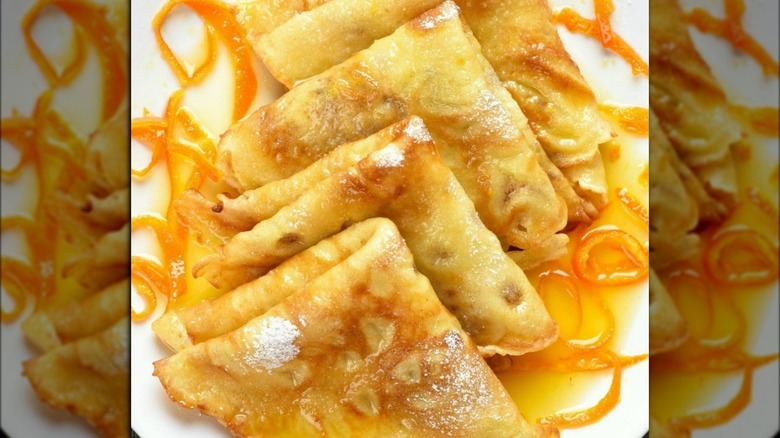The Disastrous Royal Origins Of Crêpes Suzette
The late Queen Elizabeth II modernized the British monarchy, and King Charles III is expected to advance it further through his eco-conscious food agenda. Nevertheless, a resurgence of interest in crêpes Suzette suggests the Edwardian era might be making a comeback, assuming you subscribe to the dessert's origin story involving King Edward VII, who reigned from 1901 until 1910.
As said story goes, the buttery orange crêpes, which are caramelized using the flambé method, were originally envisioned by the French chef, Henri Charpentier (1880-1961), as thin French pancakes (i.e. crêpes) served tableside from a chafing dish along with a brandy-infused sauce (sans fire). In his memoirs (via Tatler), Charpentier recounts how, in 1895, he was serving dessert to the then-Prince of Wales at the Cafe de Paris in Monte Carlo, Monaco, when disaster struck.
During the tableside prep, the heat from the chafing dish caused the brandy in the sauce to ignite. Although caught by surprise, Charpentier quickly pivoted to ladling the flaming sauce right over the pancakes. Turns out, the Prince was taken with the innovative new dish and went on to dub it "crêpes Suzette" — after one of his dining companions. But that's pretty much all that food historians seem to agree upon — if that.
Who was Suzette?
Prince Albert Edward of Wales, the future King Edward VII, married then-future Queen Alexandra in 1863 but is believed to have entertained other female companions at various times. Accordingly, some tellings of the crêpes Suzette's origin story leverage the "playboy prince" angle, which is to say they maintain that "Suzette" was a grown woman with whom the Prince was dining, sans Princess Alexandra. In a less salacious version, however, Suzette was the young female child of one of the future king's friends. As that one goes, the young Suzette was so enthralled with the dramatic-looking dessert that she spontaneously rose from her seat and curtseyed to the chef. Exuberant that his "disastrous" dessert had been so well-received, Charpentier magnanimously offered to name the dish after the Prince. Taking note of his dinner guest's delight with the dish, however, the Prince suggested it be named after young Suzette.
But there is a problem with this story. Flambé had been invented long before this historical moment. The fact that flambé was already a thing casts potential doubt on Charpentier's story of crêpes Suzette as serendipitous royal snafu. Indeed, other versions of the origin story involve neither the British royals, nor any sort of cooking disaster, for that matter.
Less disastrous versions of crêpes Suzette's royal origins
A different crêpes Suzette origin story attributes its invention to Charpentier's cooking teacher, Auguste Escoffier. In this iteration, however, curaçao caused the sauce to ignite, as opposed to the brandy used by Charpentier, or the Grand Marnier frequently used today. Another version involves a different French chef, the owner of Paris' Restaurant Marivaux, and a different Suzette, the French theater actress, Suzanne Reichenberg. Reichenberg was known professionally by the name "Suzette." In 1897, Reichenberg was playing a character who served flambéd crêpes to the others onstage on a nightly basis. Restaurant Marivaux supplied the pancakes, and at some point, its chef/owner started referring to the dish as "crêpes Suzette," after the actress.
Finally, there's another royal version of the crêpes Suzette origin story. However, this one involves, not the British throne, but the French. As it goes, the 18th-century French princess Suzette de Carignan is said to have asked King Louis XV's chef to whip up a dessert consisting of crêpes flambéd in a buttery orange alcohol-infused sauce. After the dish was deemed a success by the king, it came to be known by the princess' name.
Ultimately, historians may never come to agree on the true origins of crêpes Suzette. Presumably, however, its fans will continue to love its spectacle and its caramelized orange booze-infused goodness.


